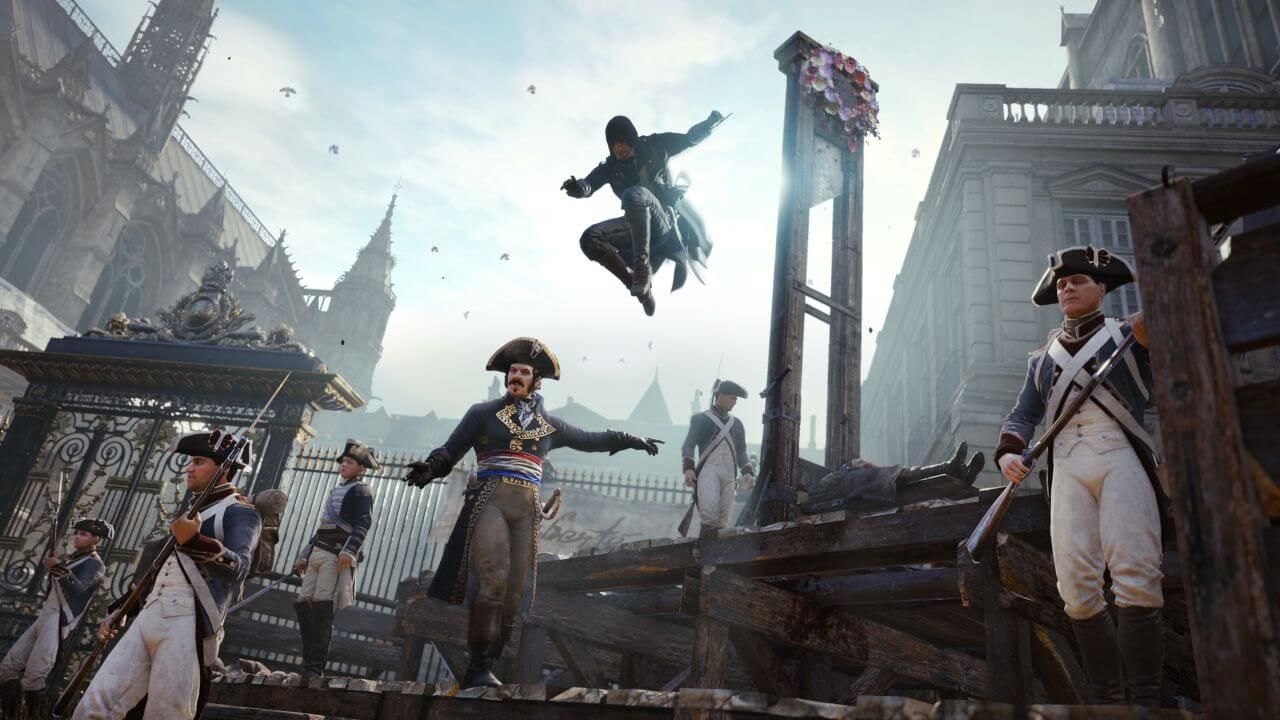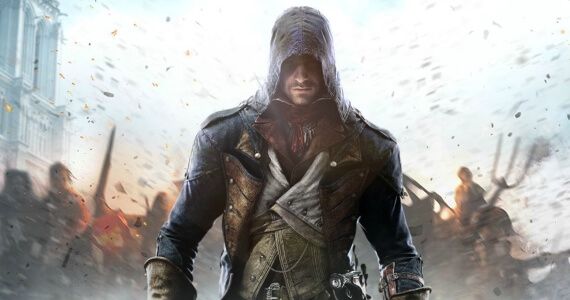Nobody can argue that the Assassin's Creed series has proven one of the most influential in the third-person action genre, with traversal and parkour all but expected these days. While Ubisoft's success may have led some to accuse the series of sticking to the same formula, the most recent shift to the open sea with Black Flag came as a welcome change of pace. But from a technical perspective, the changes in store for Assassin's Creed: Unity put those of the past to shame.
From the first announcement of Unity, the game seemed to be another reliable premise for an AC adventure: set against the backdrop of the French Revolution in Paris, the arrival of the Xbox One and PS4 meant the city streets and historical fiction would look better than ever before. But having seen some of the game in action at E3 2014, the developers seem to have addressed more issues and challenges than many would have guessed.
The mission shown during our demo of Unity was the same one shown during Ubisoft's pre-E3 press conference, in which Unity's hero Arno Dorian sets out to assassinate the devious 'Captain Xavier.' The rustic backdrop and bustling streets of Paris showed the next-gen horsepower driving the game's environments, but seeing it up close reveals just how much detail has been packed into the city's architecture and textures. The exotic settings of AC have always impressed, but the depth and detail seen here is incomparable (at least on consoles).
The cinematic trailer that accompanies the announcement showed that Arno (and his friends) would be just as deadly as his predecessors, but despite the brief story details offered, it is clear that early on, the star of Unity is the city of Paris itself. Fans may have been so enthused to see the French Revolution confirmed as the next setting (a longtime fan favorite option) that they overlooked one thing: Paris will be the only city in which the game's action is set - a first for the franchise, and a decision that Ubisoft did not make lightly.
Using the power of next-gen hardware to shrink the scale of a sprawling open world to a single capitol city doesn't make much sense, and even the development team was unsure that a single city would offer enough content for what fans have come to expect. But those fears disappeared when the sheer size and density of Unity's Paris became clear. Built on a 1:1 scale of actual 18th century Paris - another first for the series, having used 'estimations' of Boston and New York in AC3 - the city proved more than large enough.
[HTML1]
Ubisoft Montreal claims that the shift to an actual scale model of Paris (although perhaps not replicated exactly) resulted in a city that, for lack of a better word, felt more natural. Streets, passageways, and neighborhoods no longer feel artificially designed with gameplay over realism, but a closer approximation of a real-world city.
It's difficult to know whether that shift will alleviate the nagging issues with the series' core traversal (running up doorframes, accidentally leaping to one's death), but the developers have promised a "reinvention of Assassin's Creed" in terms of mechanics, and it's easy to see what they mean. Perhaps "reinvention" is too strong a word (the game is still Assassin's Creed, after all), but the team has made several improvements which should prove popular. For starters, players can now 'parkour down' from a building's roof, meaning players aren't risking a jump from a lethal height, or being pulled out into the prescribed 'Leap of Faith' animation.
Those leaps are still there, but now Arno can just as quickly run to a building's ledge, drop onto a lower handhold, and quickly descend safely. The solution to a years-old problem is a simple one, but the added precision and control in climbing is continued into the rest of the game. Players are not forced to follow the straight paths along a building's exterior, now able to shift Arno's direction with a simple change in button commands, with the next-gen hardware smoothing out the animations into the closest recreation of Prince of Persia-like wall-running and acrobatics we've seen from the series.
The combat has been similarly tuned with the usual criticisms in mind. In the past, what should have felt like challenging combat encounters too often turned into a mindless minigame: waiting for an enemy to attack, then countering with a single button-press for an instant kill. Now the team boasts that they have improved the fighting mechanics, requiring players to execute perfectly-timed parry's to knock enemies off balance and attack.
The system seemed more nuanced (and potentially more engaging), but it's difficult to tell if it will remain a fresh one after hours of gameplay. However, players will no longer be left to wonder why opponents prefer to attack one at a time, as multiple enemies will now strike together. If the fight gets large enough soldiers will simply hang back from their engaged comrades, and open fire upon Arno. For the first time in quite a long while, players may be better off simply causing a distraction and running for their lives.
Of course, that's assuming gamers wind up in a fight in the first place. All will be happy to hear that Ubisoft has made specific attempts to correct one glaring issue with nearly every AC title to date: Assassins are supposed to be silent killers, not brash sword masters. With the addition of a 'Stealth button,' players can drop Arno into a lower stance, concealing himself behind or against cover. Too little of the mechanic was shown to gauge its significance in the final game, but the developers claim they intend to give stealth fans a legitimate chance to succeed using little else. Whether it works or not, it's a step in the right direction.
The absence of loading screens and disguised gates (moving into and out of buildings and houses without hesitation) show that the next-gen design is already improving the overall experience. And the new generation of online multiplayer is alive and well with the series, having announced 4-player co-op support (with one bombastic cinematic trailer). Simply head into a local Tavern, and look for your online friend for the chance to join him on his mission, seamlessly.
Our gameplay demo ended with a brief tour of the side streets surrounding the iconic (and colossal) Notre Dame Cathedral; a building which loomed over revolutionary France every bit as much as Unity's marketing. It was promising to see the individual AI-driven citizens going about their business, occasionally stopping to break into conversation, fight, or simply offer a hint that an additional side quest may be possible (the studio's newly added 'murder mysteries'). But Notre Dame was the centerpiece.
Massive but unclear from a distance, the enormous cathedral (which took the developers 8 months to complete in its current state) resolves itself with increasing detail as Arno approaches through the flow of pedestrians. It alone shows the visual prowess that Ubisoft Montreal is pursuing, but it's the sliver of space in the massive double doors standing ajar that sends the point home.
As Arno stands with Paris at his back, a single step through the door reveals the enormous interior of Notre Dame, constructed with the same level of detail - appearing instantly. It's a space so immense that even a sprinting Arno seems to move at a snail's pace through its interior which is more akin to the complex Assassin's Tombs of previous games - puzzle chambers which stood distinctly apart from the larger world.
In many ways, Notre Dame embodies much of Unity as it exists today: at one time, out of focus but now ever-present. Now it has come clearly into view, and like the iconic cathedral at its heart, we only hope the game can deliver on the opportunity Ubisoft Montreal has afforded itself.
_____________________________________________________________
_____________________________________________________________
Assassin’s Creed: Unity will be released for PC, PS4 and Xbox One in late 2014.
Follow Andrew on Twitter @andrew_dyce.



